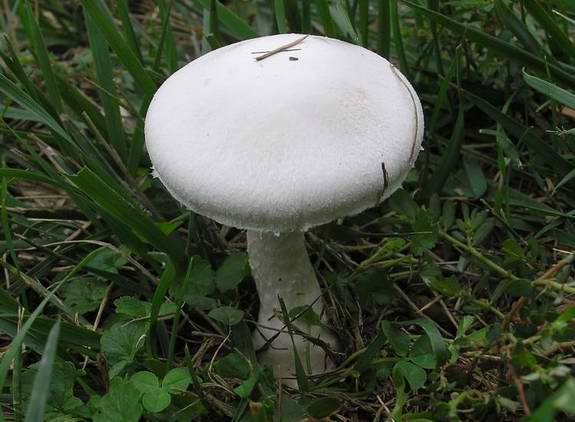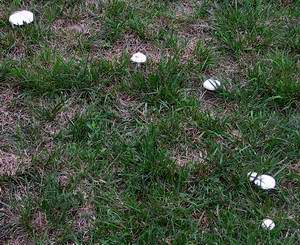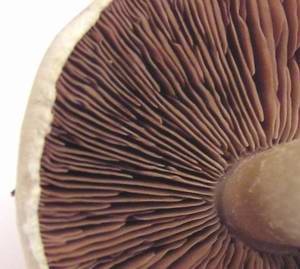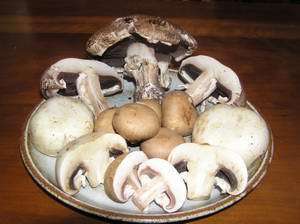|
Return to Hiker's Notebook Home Page
Common Name: Meadow Mushroom, Field mushroom, Pink gill - The mushroom is most typically found in grassy meadows and open fields.
Scientific Name: Agaricus campestris - The generic name is from the Greek agarikon meaning fungus which is thought to derive from either the city of Agaria or the river Agarus which were located in a region called Sarmatia on the north shore of the Black Sea. Campestria is the Latin word for flat, level country, like a field.
The meadow mushroom may well have been one of the first of the fungi to be
tested for edibility by humans in search of alternative sustenance during
temporal periods of scarcity. This hypothesis is supported by the
characteristics of its habitat, appearance and geographic dispersion. Meadow
mushrooms are found in open, grassy habitats such as pastures, gardens,
compost piles and other cultivated areas that are associated with human
habitation. They are whitish in color and stand out starkly
The ubiquity, obtrusiveness and the pristine appearance of the meadow
mushroom have made it one of the most common of the wild edible mushrooms. The
only major problem is that it has a deadly doppelganger that grows in the same
habitat and can be found intermingled with the agarics. The
Amanita virosa is commonly
known as the "destroying angel" for a very good reason. It is angelic in
appearance, standing out in graceful shining white perfection against a brown
or green background. However, it is destroying in its effects if eaten;
gastrointestinal distress in the form of cramps and diarrhea is followed after
about 24 hours with kidney or liver failure that not atypically has a fatal
result absent aggressive treatment up to and including organ transplantation.
One of the theories that has been advanced about the association of mycophobia
with some countries like
The taxonomic history of Agaricus bisporus is not clearly established; it was cultivated in France in the early 18th Century as a apparent variety of A. campestris. The Danish mycologist Jakob Lange named it Psalliota hortensis var. bispora in the early 20th Century, the genus name is from the Greek word psallion which means "ring" or "chain" which was probably in reference to the partial veil remnant annular ring around the stipe (stem). It was sequentially renamed Psalliota bisporus and finally Agaricus bisporus about 60 years ago. It is sometimes also called Agaricus brunnescens to account for the tendency of the mushroom to stain brown when bruised (according to Tom Volk of the University of Wisconsin). The species name bisporus means two spores, which is a very significant distinguishing characteristic. Gilled mushrooms are in the class Basidiomycetes named for a structure called the basidium on which four basidiospores are produced. A. bisporus only produces two spores instead of four. When the reproductive nuclear division called meiosis occurs, each of the two spores ends up with two nuclei, one from each parental mating type. The consequence of this is that each spore of the button mushroom is capable of sexual reproduction without the need to find a compatible sexual mate like the other basidiomycetes with their four spores each with a single parental nucleus. The self-fertilization of the button mushroom contributed to its spread, if limiting any variation experimentation with the species.
Among the largely forgotten English culinary traditions of the 18th Century is the production of ketchup from mushrooms. This predates the introduction of the first commercial tomato catsup which was marketed by the Henry J. Heinz in 1875. If one looks up the word ketchup in any of the more thorough dictionaries, the mushroom provenance is evident. The Oxford English Dictionary defines ketchup (or catsup) as "a sauce made from the juice of mushrooms, walnuts, tomatoes, etc." This may seem a contradiction as the British are notoriously mycophobic, contemptuously referring to mushrooms as toadstools (a calque word of German origin - todesstuhl literally means "death chair"). The English herbalist John Gerard opined in the seminal Herball or Generall Historie of Plantes in 1597 that "most of them [mushrooms] do suffocate and strangle the eater." It seems that Continental excursions by the English gentry resulted in their eventual familiarity with French traditional cuisine which included truffles, morels and cultivated champignons, a relative of A. campestris.
The meadow mushroom was thus one of the only wild mushrooms accepted by the British and it gained attendant approbation as a comestible. This is supported by historical literary evidence. In 1847, Anna Hussey wrote in Illustrations of British Mycology that Agaricus campestris were "tender, succulent, friable and digestible, nourished on pure earth, in air redolent of wild thyme and the breath of kine, by dew which might be Fairies' nectar it is so free from the impurities of city miasma." It is also more than likely that A. campestris was the mushroom used in ketchup, as M. C. Cooke wrote in British Edible Fungi in 1891: "In rural districts where ketchup is an annual autumnal event, the meadow mushroom is preferred as more highly flavored." A typical English home recipe for ketchup consisted of mace, cloves, and ginger added to whole or diced meadow mushrooms. After about a week, the now deliquescent mixture was heated, strained and mixed with red wine, port or brandy. The consumption of mushroom ketchup was likely the prevalent form of fungal consumption in Great Britain in the 18th Century. George Watkins mushroom ketchup is still available commercially to this day for the adventurous gourmand.
Agaricus campestris and the closely related Agaricus bisporus, the button or white mushroom, are central to the inchoate cultivation of wild mushrooms. The French agriculturalist Olivier de Serres is credited with the hypotheses that mushrooms could be vegetatively propagated in his seminal agricultural primer Th��tre d'Agriculture in 1600. The origins of the cultivation of mushrooms is somewhat uncertain. The most reliable account is that of Joseph Pitton de Tournefort, who was a renowned French botanist credited with the concept of genus as a means of classifying plants. In a paper to the French Academy of Sciences in 1707, he wrote of the "Parisian" method of mushroom growing which "favorise la pens�e de ceux qui croient que les champignons naissant de grain de meme que les autres plantes," - favors the idea that mushrooms grow like plants. He credited the botanist Marchant p�re (the father) with having demonstrated the propagation of mushrooms in horse dung in 1678 - the theory being that the horse dung contained mushroom seeds.
From its humble beginnings in the fields (les champs) of France, the champignon became the world's most popular edible fungus; in 1975 it comprised 73.1 percent (670,000 metric tons) of the global market. The original mushroom farms tenuously operated on the empirical observation that mushrooms emanated from transplanted mycelial substrate from earlier mushroom growth in a mixture of manure and plant detritus such as straw. Over time, it was discovered that champignons did not need to be in the "les champs" at all, and that, in fact, they thrived in total darkness. Further, the uniform cool temperatures and high humidity of underground caverns proved the ideal habitat, and the Champignons de Paris grown in the caves near Paris became the cynosure of the nascent cultivated mushroom industry. As the button mushroom spread to other countries and demand increased, the grower as spelunker gave way to advanced composting technologies. Agaricus bisporus is known as a secondary decomposer, for, unlike most other (wild) mushrooms, it does not decompose plant cellulose and lignin directly. The process of compost formation for the growth of A. bisporus growth thus necessitates a binary process. The first step consists of the familiar exothermic breakdown of plant nutrients by bacteria; the second step is essentially a Pasteurization process to kill off any unwanted organisms, including other undesirable, though prevalent fungi. Once this is accomplished button mushroom spawn is introduced so that the mycelia will permeate the partially decomposed and purified compost. Fruiting is induced by a covering layer of "casing soil," and, after about three weeks, the first of three to five flushes of mushrooms are ready to harvest. The spread of the white Agaricus bisporus and its increasing popularity led to the development of mushrooms with superficial variation to appeal to a wider market. The crimini mushroom was first grown in Italy in the 19th Century as the Italians co-opted the French champignons, preferring a variety of A. bisporus with a brown cap (pileus). The Portobello (aka portabella or portobella) is a fully grown and expanded crimini. It is thought to be an American invention that emerged in the late 1980's and is not named for Portobelo, Panama, nor for anything else so far as is known. Button, Crimini and Portobello A. bisporus
Since the white button mushroom is widely consumed by diverse populations, there has been some investigation into its nutritional, medicinal and toxic qualities. Like most mushrooms, Agaricus bisporus is highly nutritious with generous levels of potassium, phosphorus and calcium in addition to all of the nine essential amino acids used in protein synthesis. Several studies have shown that the button mushroom suppresses aromatase activity and the biosynthesis of estrogen and can be used medicinally to reduce the risk of breast cancer in women. Agaricus mushrooms contain agartine, a hydrazine derivative that has been found to be carcinogenic in mice. However, heating the mushrooms above 100 degrees Centigrade for 10 minutes volatizes the hydrazine to minimize any potential deleterious toxic effects. |


 against
the green of their surroundings, growing singly in frequently abundant
groupings. They sometimes take the form of "fairy rings," which occur due to
the outward growth of the mycelium, the underground body of the A.
campestris fungus; the mushroom fruiting bodies occur at its outer
perimeter. The gills of the immature mushroom are pink, which, combined with
the pallid cap, have an inviting appearance of edibility, supported by their
generally pleasant fungal aroma. They have a global presence with widespread
distributions in Asia, Europe and North America.
against
the green of their surroundings, growing singly in frequently abundant
groupings. They sometimes take the form of "fairy rings," which occur due to
the outward growth of the mycelium, the underground body of the A.
campestris fungus; the mushroom fruiting bodies occur at its outer
perimeter. The gills of the immature mushroom are pink, which, combined with
the pallid cap, have an inviting appearance of edibility, supported by their
generally pleasant fungal aroma. They have a global presence with widespread
distributions in Asia, Europe and North America.  Great Britain and mycophilia with other countries like Russia is that in the
former an amanita was first selected for trial and in the latter it was an
agaric. This may have been the inspiration for the mycophagic commentary in
Hart's BC cartoon.
Great Britain and mycophilia with other countries like Russia is that in the
former an amanita was first selected for trial and in the latter it was an
agaric. This may have been the inspiration for the mycophagic commentary in
Hart's BC cartoon.